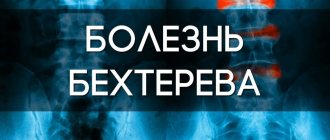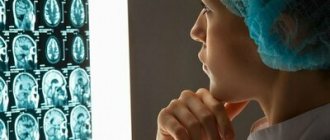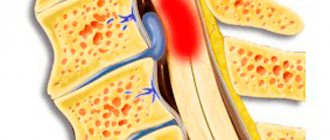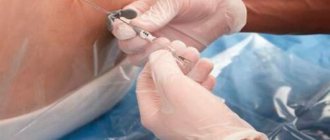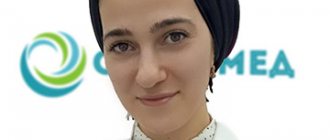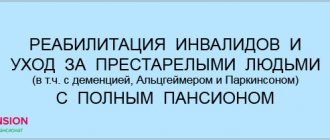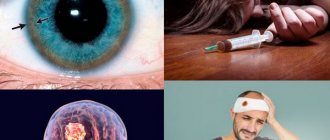Paresis is a partial paralysis in which the patient is unable to perform various actions and movements, which is caused by serious damage to the central or peripheral nervous system.
Diagnosis of paresis in the neurology clinic of the Yusupov Hospital is comprehensive, with the involvement of specialists from various fields of medicine: psychoneurologists, otolaryngologists, neurosurgeons, psychiatrists, pulmonologists.
General information
Motor disorders are a symptom that accompanies various neurological diseases. They are associated with damage to the motor departments of both the central and peripheral nervous systems, which leads to partial or complete impairment of movements. Paresis is a limitation of movement and a decrease in muscle strength. A more severe form is paralysis (or plegia), in which voluntary movements are completely absent.
We can say that motor excitation is transmitted along a “two-story” cortical-muscular pathway - from the brain to the muscles (pyramidal pathway). The top floor is the brain, from where the impulse is transmitted to the spinal cord. If this motor pathway is disrupted, central paralysis or paresis develops. Central movement disorders are characterized by weakness in the arms or legs, increased reflexes, and the gradual development of spasticity.
The lower level of the pathway includes the spinal cord, from which the impulse is transmitted to the nerves in the periphery, which provide muscle movement. If this motor pathway is disrupted, peripheral paralysis or paresis develops. Peripheral paresis and paralysis are sluggish due to developing muscle hypotonia and occur with muscle weakness and atrophy. Thus, motor disorders can be caused by lesions not only of the brain, but also of the spinal cord, as well as peripheral nerves, which for some reason stop transmitting impulses from the brain to the muscles. Central paralysis is characterized by muscle spasticity - muscle tension that occurs involuntarily. Spasticity is characteristic of cerebral palsy, multiple sclerosis , encephalomyelitis , traumatic brain injury , and stroke . Code for spastic paraparesis according to ICD 10 - G82.1
Complications of foot paresis
In the absence of proper treatment for foot paresis, symptoms intensify, which can cause complications:
- Decreased muscle strength in the legs;
- Foot deformity. (At the beginning of the disease, the patient can easily return the foot to the correct position, but over time this will become increasingly difficult, which can lead to ossification of the foot in the wrong position). To prevent foot deformation, it is necessary to diagnose and determine the cause of the defect: intervertebral hernia, muscle spasm or another cause.
- Foot paralysis occurs in severe form. In this case, it is very important to fix the foot in the correct position, for which orthopedic shoes can be used.
Timely seeking qualified medical help for the treatment of cauda equina will help the patient move freely again.
Get a free consultation by phone
Pathogenesis
If we consider acquired motor disorders in trauma, then at the moment of exposure to traumatic force, direct damage to brain tissue develops. Compression, contusion of the parenchyma and circulatory disorders occur in it. The outcome of these pathological changes is necrosis , developing in the brain or spinal cord. At the same time, the mechanism of secondary damage is triggered - ischemia and inflammation. The necrotic focus gradually turns into a connective tissue scar, which is surrounded by post-traumatic cysts.
The consequences of brain damage are interruption of pathways at different levels, associated with necrosis and atrophy . With a spinal cord injury, control of the muscles innervated by segments below the level of injury is lost. The possibility of functional restoration depends on the restoration of conduction along the spinal cord. If the conductivity of the spinal cord is completely disrupted when it is interrupted, automation develops in those sections that are located below the interruption. In case of partial disruption of conductivity, there is the possibility of slow restoration of functions after elimination of edema , inflammation and circulatory disorders due to the remaining fibers.
The pathogenesis of cerebral palsy is different. Birth trauma is thought to result in asphyxia and brain damage. However, as a cause of cerebral palsy, birth trauma matters only in 5-10%. There are other and more significant mechanisms for the development of the disease: impaired brain formation, intrauterine damage to neurons, diseases that occur in the first week of life. Brain damage (ischemia or trauma) before the child’s age of three, which also causes motor disorders, cannot be ruled out.
ethnoscience
The use of traditional medicine in the treatment of limb paresis at home cannot be ruled out. But this should not be the only treatment. All methods are agreed upon with the doctor and only then applied.
Traditional medicine recipes:
- Ingestion of chamomile decoction. It is drunk as herbal tea.
- Rosehip decoction, you can add hawthorn to it. But you need to control the amount of drink you drink. They have diuretic properties.
- Treatment with celery and beet juice. You can add carrot juice.
- Valerian tincture is useful in the form of a rub . It is rubbed directly into the sore spot.
- Cold and hot shower. You need to start lowering the temperature gradually and increase the duration of the procedure to minutes.
Such measures and procedures can improve the immune system and improve blood circulation. This will help restore the functioning of muscles and ligaments.
Classification
The following types of movement disorders are distinguished depending on their prevalence:
- Monoparesis (monoplegia) is muscle weakness or loss of movement in one limb and on one side.
- Paraparesis (paraplegia) is muscle weakness or loss of movement in two limbs (or both arms or both legs). Depending on this, in neurology there is paraparesis of the lower extremities or paraplegia of the lower extremities and, accordingly, paraparesis or paraplegia of the upper extremities (synonyms lower paraparesis/plegia and upper paraparesis/plegia).
- Hemiparesis (hemiplegia) is muscle weakness or loss of movement in the upper and lower limbs, but on one side. That is, hemiparesis and hemiplegia can be right-sided or left-sided.
- Diplegia is damage to both halves of the body.
- Triparesis (triplegia) is a disorder of movement of three limbs.
- Tetraparesis (tetraplegia) – in case of movement disorders in four limbs.
According to the level of damage to the nervous system, movement disorders are divided into:
- Peripheral.
- Central.
- Mixed.
According to the degree of severity, movement disorders are:
- Mild degree.
- Moderate.
- Deep.
- Complete paralysis.
According to muscle condition:
- Spastic paralysis (paresis) is a pathological muscle tension with weakness of movements that develops in the arm or leg.
- Flaccid paralysis (paresis) is a pronounced relaxation of the muscles, but their shortening does not occur. When peripheral motor neurons are damaged, peripheral paralysis develops - they are called flaccid paralysis.
The spastic form of paralysis with increased muscle tone indicates damage to the central motor neurons. Spasticity occurs in many diseases of the central nervous system: stroke , encephalitis , Strumpel's disease , traumatic brain injury , cerebral palsy, multiple sclerosis , spinal injury , brain tumors and , amyotrophic lateral sclerosis . Acute damage to central neurons first manifests as flaccid paralysis, and then increased muscle tone. Thus, with strokes, motor impairments of varying degrees develop and, along with a decrease in strength, muscle tone changes towards spasticity. Post-stroke spasticity develops in 68% of patients, affecting the arm and leg.
With spinal injury , multiple sclerosis and spinal stroke, lower spastic paraparesis appears. In multiple sclerosis and cerebral palsy, spasticity is accompanied by muscle pain and the development of contractures.
Spastic diplegia is a common form of cerebral palsy, the clinical picture of which is tetraparesis - all limbs are affected, but the legs are predominant. Movement disorders can vary from awkward movements in the limbs to severe paresis.
Spastic diplegia is called Little's disease . Identified in premature infants with intraventricular hemorrhage or leukomalacia . In mild cases of the disease, symptoms appear by six months, and in more severe cases, tetraparesis is noticeable from birth. With this pathology, children begin to sit up late, and when walking they make “dancing” movements, their legs cross and there is emphasis (on their toes). In children, bone growth is disrupted, spinal curvatures and joint contractures develop very early. This disease causes speech delay and speech impairment. There may be pathology of the cranial nerves, which manifests itself in strabismus and atrophy of the optic nerves , as well as hearing impairment.
Tetraplegia is associated with more severe damage to the cerebral hemispheres, brainstem, or cervical spinal cord. May be associated with congenital (cerebral palsy) or acquired diseases. Acquired forms develop after severe traumatic brain injury, hemorrhage, as a result of tumors of the brain or spinal cord, encephalitis, or complications of neurosurgical operations. Flaccid tetraparesis occurs with muscle weakness in the arms and legs. spastic tetraparesis develops (double hemiparesis or double hemiplegia), which in children is considered a form of cerebral palsy. Patients have constantly increased muscle tone and cannot relax them. Without treatment, complete loss of movement and motor skills occurs. Increased spasticity is accompanied by muscle pain. Spasticity is also noted in the neck and tongue, so such children cannot speak (the tongue does not obey them). There is also mental retardation.
Strumpel's disease
Strumpel's spastic paraplegia is a hereditary disease that is caused by degenerative changes in the motor neurons of the spinal cord. Motor neurons enter the pyramidal tract, which begins in the cerebral cortex and ends with mononeurons in the spinal cord. Wikipedia clarifies that a feature of the disease is progressive spasticity and gait disturbance. For an unknown reason, the transport of proteins and lipids, which are necessary to maintain the structure of the cell, is disrupted in motor neuron cells. This disease is not a form of cerebral palsy, although it manifests itself as spastic diplegia .
The initial signs of Strumpel's disease appear at 10-15 years of age, but there are cases of the disease developing from early childhood. Characteristically symmetrical lesions of the legs. Patients are concerned about fatigue and stiffness in the legs, which appear after long walking or intense exercise. The leading cause is muscle spasticity and increased tendon reflexes. An increase in muscle tone causes the symptom of “crossed legs”, protective reflexes and bending of the legs at night appear. The later the disease appears, the more pronounced the spasticity and increased reflexes. Tendon contractures also develop (more so in the ankle joints). As the disease progresses, in the advanced stage, patients have difficulty walking, stumble and fall. There are no trophic disorders in the muscles (no atrophy), and there are also no dysfunctions of the pelvic organs.
Treatment
As a rule, paresis is primarily manifested by discomfort in a certain muscle group. The lack of adequate treatment threatens to develop this condition into complete paralysis. Most often, patients complain of feeling severe pain in the area where partial immobility has developed.
The main stages of treatment are: initial identification of the cause of paresis and its subsequent elimination. Patients after strokes require special rehabilitation therapy. In cases of trauma and other damage, specialists often have to resort to suturing peripheral nerves.
If tumors and other neoplasms are detected that compress the nerves, it is necessary to carry out surgical intervention aimed at their removal.
In addition, patients at the Yusupov Hospital are prescribed special massage courses to help maintain muscle tone, since constant partial immobility can lead to their atrophy.
Treatment of leg paresis
First of all, specialists at the Yusupov Hospital carry out therapeutic measures to eliminate the root cause of the disease. Treatment of lower limb paresis is always complex. It involves drug therapy, therapeutic exercises, massage (including mechanical), HAL therapy (gymnastic exercises using robotic complexes).
Treatment of radial nerve paresis of the arm
According to indications for paresis, the Yusupov Hospital carries out etiopathogenetic therapy aimed at eliminating the cause of the disease and preventing its further development. Patients are prescribed a course of antibacterial, anti-inflammatory, decongestant and detoxification therapy. If necessary, the dislocation is reduced, bones are repositioned in case of fractures, a fixing bandage is applied, etc.
Treatment of laryngeal paresis
Treatment of laryngeal paresis, like all other types of paresis, begins with eliminating the underlying disease that led to the development of this pathology. The main method of treatment is drug therapy, which is prescribed individually, depending on the etiological factors: taking antibacterial or antiviral drugs, B vitamins, biogenic stimulants, stimulants of muscle activity, psychotropic drugs, vascular drugs and nootropics.
Treatment of paresis of the median and ulnar nerves
For this type of paresis, the Yusupov Hospital provides the following treatment:
- drug therapy: taking anticholinesterase drugs, B vitamins, desensitizing agents, NSAIDs, analgesics, sedatives, hypnotics;
- physiotherapy;
- massotherapy;
- physiotherapy;
- surgical treatment (if there are no positive results from the above methods within 1-2 months).
Highly qualified specialists of the Yusupov Hospital Rehabilitation Center have extensive experience in treating paresis of any localization. An individual treatment strategy is developed for each patient, aimed at the fastest possible recovery. To carry out drug therapy at the Yusupov Hospital, only the newest medications are used, which have proven in practice their high effectiveness and the absence of side effects. Patients are provided with cozy rooms equipped with everything necessary for a comfortable stay in the clinic.
You can make an appointment with a specialist, get information about the cost of services for diagnosing and treating the disease, and the conditions for hospitalization of the patient by calling the Yusupov Hospital or on the clinic’s website, using the feedback form. The coordinating doctor will answer all your questions.
Causes
Most movement disorders are caused by degenerative diseases, either congenital or acquired.
Paraparesis in adults and its causes
If congenital diseases ( adrenoleukodystorophy , which occurs with myeloneuropathy , Strumpel's disease ) and cerebral palsy are excluded, then most often paraparesis of the lower extremities is caused in adults by the following pathologies and conditions:
- Compression lesions (prolapsed intervertebral hernia , bone spines, thickened spinal ligaments that narrow the spinal canal and compress the spinal cord).
- Hepatic encephalopathy , in which spastic paraparesis is associated with the toxic effects of endotoxins.
- Injury to the spine and spinal cord, which leads to loss of movement and dysfunction of the pelvic organs. Spinal cord injuries very often lead to significant motor impairment and disability in patients.
- Tumors of the spinal cord.
- Infectious diseases ( encephalitis , Lyme disease , AIDS, neurosyphilis ).
- Autoimmune diseases ( systemic lupus erythematosus ).
- Epidural abscess.
- Vascular pathology of the spinal cord (epidural and subdural hemorrhages, blockage of the anterior spinal artery).
- Poisoning (medicines and alcohol).
Causes of central paresis:
- Traumatic brain injuries.
- Intervertebral hernia.
- Cerebral palsy.
- Strokes.
- Spinal cord injuries.
- Tumors (brain and spinal cord).
- Amyotrophic lateral sclerosis.
- Multiple sclerosis.
From the practice of a neurologist
As an example, it is worth citing a treatment regimen for lower paraplegia, of central origin, due to spinal cord injury in a young patient, where complex treatment had a noticeable effect:
- Actovegin
- intravenous stream; - Trental
- intravenously; - Prozerin
; - vitamin B12
intramuscularly; - massage of the lower extremities
in combination with physical therapy; - acupuncture and electrical myostimulation
of extensor muscles
This is a set of measures that were prescribed in addition to independent physical activity on the shoulder girdle and early learning to sit in bed, to help overcome the fear of which psychotherapy sessions helped.
The combination also gave satisfactory results:
- muscle relaxant Mydocalm
; - Sibazon,
which has a complex sedative-hypnotic, anticonvulsant and anxiolytic effect ; - Pentoxifylline
is a means to improve microcirculation; - Milgamma
is a complex of B vitamins; - ATP
- tissue energy stimulator; - Cerebrolysin
is a nootropic drug.
Symptoms
Let's look at common motor dysfunctions.
Spastic diplegia
The most common form of cerebral palsy. The clinical picture shows spastic tetraparesis, that is, the function of the arms and legs is impaired, but the lower extremities are more affected. Patients have increased tone not only of the muscles of the arms and legs, but also of the body, as well as the tongue. Small children cannot sit or walk. The majority have pseudobulbar syndrome - articulation (articulate pronunciation), phonation (sound production), swallowing and chewing suffer. This form may be complicated by convulsive syndrome. Pathological attitudes are noted and a spastic gait with a cross is formed. Due to muscle tension, the patient has difficulty bending his legs at the knee joints and does not lift his legs off the floor.
Patients develop early deformities of the arms and legs, contractures , and curvature of the spine . High muscle tone causes pathological attitudes - crossing the legs and bending the knee joints. Characteristic poses develop: the triple flexion pose and the ballerina pose.
Children's intelligence is normal or reduced, and there may be hearing impairment. The degree of increased tone varies from mild to severe. Depending on this, some patients can walk independently, others with support, and others need to move in a wheelchair.
Spastic hemiparesis
With this form, the movements of the arms and legs on any one side of the body deteriorate. In the clinic it can manifest itself as left- or right-sided hemiparesis . At the same time, its expression is greater in the hand. This form is characterized by the fact that spasticity is more pronounced in the leg extensors and arm flexors. Therefore, the affected arm is bent at the elbow and brought to the body, the hand and fingers are also bent (the expression “the hand asks”) is used.
If we talk about cerebral palsy, then from birth the baby has a difference in movements in the arm and leg on the affected and healthy half. Limbs with paresis lag behind healthy ones in growth—the difference in their length is noticeable. The standing posture becomes incorrect and the foot is placed “on its toes”. Shortening the limb leads to poor posture and pelvic distortion.
When a child begins to walk confidently, he develops a hemiparetic gait. When walking, he “circles” a circle with the affected leg: it is extended at the knee joint and performs circular movements outward, and the torso deviates in the opposite direction. This bent position of the arm and leg, which makes circular movements when walking, is called Wernicke-Mann pose .
Hemiparetic gait occurs with lesions of the brain and spinal cord: strokes , abscesses , encephalitis , brain trauma , tumors , toxic injuries and hereditary degenerative processes. In patients, the muscles on the affected side are dense to the touch and their relief is sharply contoured. If several passive movements are performed in a limb in a row, then muscle tension decreases. When examining a patient, a “jackknife” symptom is often encountered - with passive movement in the elbow or knee joint, the patient feels muscle resistance, and then it decreases.
Inferior flaccid paraparesis
This form of motor dysfunction is associated with damage to peripheral neurons and is characterized by:
- decreased or complete loss of muscle tone;
- amyotrophy;
- degeneration of nerves;
- decrease or disappearance of reflexes;
- muscle degeneration.
Acute flaccid paresis was previously associated with polio , but after vaccines were created more than 50 years ago and thanks to mass immunization, the territory of the Russian Federation has been considered a polio-free zone since 2002. This movement disorder can be associated with many other causes and occurs as a symptom in many diseases:
- infectious lesions of peripheral nerves ( myelitis , polyneuropathy , mononeuropathy );
- traumatic neuropathies ;
- encephalomyelitis;
- spinal cord tumors in the thoracic spine;
- spinal cord injury in the cauda equina region;
- demyelinating diseases of the central nervous system;
- transient circulatory disorders of the spinal cord;
- botulism;
- hereditary metabolic diseases (HBD);
- heavy metal poisoning;
- Guillain-Barré syndrome (acute idiopathic polyneuritis - an autoimmune disease);
- toxic effect of drugs ( vincristine , isoniazid );
- the effect of muscle relaxants ;
- myasthenia gravis;
- botulism.
Patients initially develop weakness in the leg muscles, which progresses, and the patient cannot stand or move independently. Movement with great physical stress is possible only with the help of strangers or crutches. Patients cannot maintain an upright posture if their knee joints are not fixed. Attempts to maintain a vertical position lead to bending of the legs. All this leads to the fact that the patient has to stay in bed or in a wheelchair most of the time.
They change their position in bed due to tension in the muscles of the arms and shoulder girdle. Passive movements are performed by patients without muscle tension, but active movements are performed with difficulty, and their amplitude is very limited due to severe muscle weakness. Flaccid paralysis occurs with profound disturbances in muscle movement and trophism. The muscle tone is sharply reduced, the muscles are flabby and atrophic, so the foot acquires the pes equinus (horse foot) position - the foot hangs and is bent towards the sole, which makes walking very difficult.
In acute cases ( encephalomyelitis , acute flaccid paresis ), these phenomena appear within 7-10 days, and in chronic flaccid diseases, muscle weakness and paralysis develop gradually.
Strumpel's paraplegia
Synonyms for the name: Erb-Charcot-Strumpel disease, or familial spastic paraplegia.
This is a disease with an inherited defect of the nervous system - bilateral degeneration of glia of the pyramidal tracts in the cords (lateral and anterior) at the level of the thoracic and lumbar regions of the spinal cord, with the involvement in subsequent stages of the pyramidal fibers of the brain stem and partial death of Betz cells in the motor zone of the cerebral cortex.
The mechanism of inheritance is autosomal dominant, or autosomal recessive, or it is X-linked; the genes responsible for the transmission of pathology have already been identified.
Due to genetic heterogeneity, the disease can manifest itself between the 1st and 7th decades of life as symmetrical lower spastic paraplegia, manifested by:
- gradual development;
- early appearance of tendon reflexes;
- rapid fatigue of the legs from walking;
- stiffness;
- cramps in the leg muscles of a tightening nature;
- spastic gait;
- increased level of tendon reflexes;
- clonus of the feet and patellas;
- the formation of contractures and deformities of the feet with the formation of a “hollow foot” - with its shortening and increase in height.
When the upper extremities are involved, which happens in the advanced stage of the disease, this does not affect sensitivity and intelligence.
Possible damage to the optic and oculomotor nerves (II and III pairs of cranial nerves), the occurrence of dysarthria, ataxia, nystagmus, and intention tremor.
MRI demonstrates a picture of characteristic atrophy of the spinal cord along its entire length, with particular severity in the cauda equina region.
In differential diagnosis, this disease is indicated by:
- late onset of the disease with a slowly progressive course, complicated by spastic paraplegia, with normal psychomotor development;
- maintaining the patient’s ability to walk until adulthood;
- health of heterozygous family members.
Associated symptoms
With a bilateral process in the cerebral cortex with a tumor in the upper third of the precentral gyrus, spastic lower paraparalysis is often accompanied by Jacksonian epilepsy with the appearance of clonic convulsions with their onset in the leg muscles.
In children, spastic diplegia is characterized by insurmountable spasticity of the leg muscles with a pronounced adductor dominance and the formation of a characteristic gait, or even the inability to walk independently. The pathology is also manifested by combined athetotic hyperkinesis of the muscles of the arms and face.
Tests and diagnostics
First of all, paresis and plegia are detected during a clinical examination. They are characterized by:
- decreased range of motion and muscle strength;
- changes in muscle tone;
- muscle wasting or atrophy;
- increased or decreased normal reflexes;
- fibrillation of the muscles of paretic limbs;
- the presence of pathological reflexes.
To clarify the diagnosis, patients are prescribed the following examinations:
- Echoencephalography of the brain - examination of the brain using ultrasound.
- Electroencephalography is a study of the electrical activity of the brain.
- X-ray contrast and radionuclide studies. With their help, the condition of the brain ventricles and subarachnoid space is assessed.
- Doppler ultrasound is a variant of the study of cerebral vessels.
- Electromyography. Allows you to identify changes in spinal cord motor neurons characteristic of neuropathies.
- Biopsy of the affected muscles with examination of the biopsy material.
- Cerebrospinal fluid puncture.
- CT scan.
- MRI of the brain.
How is diagnosis done?
To identify the cause and type of paralysis, you will need to consult several specialists:
- Neurosurgeon.
- Psychiatrist.
- Pulmonologist.
- Psychoneurologist.
- Otolaryngologist.
To identify the full clinical picture, a detailed examination is necessary. The patient must give blood for analysis. His psychogenic reaction is checked.
The following research methods must be used:
- computed tomography;
- magnetic resonance imaging;
- neurosonography;
- fluoroscopy.
Reflexes of the limbs are checked, the brain is examined. After this, the cause of the paralysis can be identified. The main specialist who chooses diagnosis and treatment is a neurologist.
Reflex test
Diet
Patients who do not have impaired swallowing can take regular food and sit on a common table. If a child can chew and swallow independently, his diet should consist of vegetables, fruits, eggs, nuts, meat, fish, cereals, but prepared food must be crushed (pureeed) to make it easy to swallow.
It is necessary to ensure that the diet contains a sufficient amount of protein products (meat, fish, cottage cheese, cheese and other dairy products, eggs) and complex carbohydrates, since rehabilitation treatment requires an increased supply of protein and energy. Fats must be present in the diet - butter and cold-pressed vegetable oils (olive, sesame, flaxseed).
Severe swallowing disorders require special nutrition adapted to the child’s characteristics, since problems with eating gradually lead to a deficiency of essential substances and energy. In such children, protein deficiency and energy deficiency progress. If swallowing continues, the child is additionally given formula through a tube (sipping method). Modern enteral nutrition is a mixture with an optimal composition of nutrients, vitamins, macro- and microelements.
There are dry mixtures ( Nutrien standard ), which need to be prepared by diluting with water, or ready-made mixtures - Nutrizon standard , Nutrien standard , Nutrizon energy and others. Children 3-5 years old with nutritional deficiencies are prescribed formulas for premature infants up to one year old. In severe cases, patients need special nutrition - enteral tube or parenteral.
Features of the development of childhood paraparesis
With the general normal development of the child, you can notice that he walks on tiptoes. Naturally, this becomes a cause of serious concern for parents. If a child moves independently, this does not mean that he has paraparesis.
Walking on tiptoes may be due to the fact that only some groups of leg muscles may be in good tone, which is not in all cases a symptom of paraparesis. Most often, in such situations, doctors recommend massage, as well as performing therapeutic restorative physical exercises.
In the event of a disorder, restoration processes in the children's nervous system, due to its plasticity, proceed much more actively than in the developed organisms of adults.
Therefore, the results of any significant disorders, hypoxia and birth trauma may very soon cease to appear.
If paraparesis is diagnosed in a child, it is necessary to ensure continuous monitoring by a neurologist. Observation should be accompanied by drug treatment, as well as physiotherapeutic procedures and orthopedic examination. Acupuncture can significantly contribute to the positive effect of treatment.
Prevention
Considering that the main cause of paresis in children is cerebral palsy, its prevention includes:
- improving the health of adolescents and women of childbearing age;
- treatment of sexually transmitted infections when planning pregnancy;
- regular examinations and timely detection of pathology in pregnant women;
- timely diagnosis of coagulopathies in expectant mothers;
- prevention of premature birth;
- adequate obstetric care;
- proper resuscitation, adequate care and use of hypothermia in newborns, timely treatment of hyperbilirubinemia .
In adults, the following are important:
- prevention of injuries (traumatic brain injuries and spinal injuries);
- timely treatment of hypertension , which, if left untreated, is complicated by cerebral hemorrhage;
- exclusion of alcoholism and poisoning by alcohol substitutes.
Consequences and complications
With paralysis and paresis, complications arise from the musculoskeletal system:
- joint contractures;
- pathological attitudes;
- arthrosis;
- formation of vicious poses;
- muscle atrophy.
Joint contractures are secondary and their severity depends on the severity of the disease and the age of the patient. At first, contractures develop reflexively (from muscle contraction against the background of prolonged excitation), and then become permanent due to degenerative changes in the muscles, ligaments and tendons. The combination of various contractures forms a vicious posture in patients. Motor installations are manifested by a forced position of the limb due to excessively high muscle tone. An example of a propulsion system is the equinus position of the foot, which is formed due to the traction of the gastrocnemius and soleus muscles. With Little's disease, the patient often falls and therefore receives injuries (hematomas, fractures).
What is foot paresis?
Decreased strength in a muscle or group of muscles is called paresis.
The development of such a symptom is secondary, caused by some condition or disease. Foot paresis is the general name for the problem of patients who have difficulty lifting the forefoot.
This gait disturbance caused by foot drop is a sign of pathology - muscular, neurological or anatomical. The cause of such a defect may be leg injury, intervertebral hernia, damage to the sciatic nerve and other diseases.
With foot paresis, a “cock gait” may be observed, when the patient walks by raising his leg high, throwing it forward and sharply lowering it, or pulling his toes along the ground. Paresis of the foot can be unilateral or bilateral, it can be observed constantly, but sometimes it goes away on its own. The onset of paresis can occur at any age. Weakness or paralysis of the muscles that lift the leg, caused by various pathologies, is the cause of foot paresis, so treatment for paresis can vary and will depend on the cause of the disease.
Forecast
Functional recovery depends on the severity of the damage to the nervous system. In this regard, compensation of neurological disorders, partial compensation, or the formation of persistent syndromes are ultimately possible.
A quarter of patients move independently, while the rest cannot do without walkers or wheelchairs. With good treatment, children with paraplegia or hemiplegia survive to adulthood and live almost normal lives. The effectiveness of rehabilitation for spastic diplegia depends on how severe the motor impairment is and how much intelligence is preserved. If active rehabilitation has been carried out since early childhood, a person can acquire a profession. If mental abilities are preserved, then they are well adapted in social life. In the presence of epileptic seizures, the prognosis worsens.
With tetraplegia, accompanied by impaired swallowing and the need for feeding through a gastrostomy tube, life expectancy is sharply reduced. Hereditary diseases affecting the pyramidal system ( Strumpel's disease ) progress slowly and have a favorable prognosis for life. However, the ability of patients to work is limited at the onset of the disease, and is lost as it progresses.
Forecast for the development of limb paresis
The prognosis and complete cure of paresis depends on many factors. It is difficult to cure paresis completely, but it is possible. It is necessary to strictly adhere to the advice and recommendations of the attending physician.
This will be affected by:
- patient's age;
- degree of paralysis;
- types of paresis;
- the treatment being taken;
- the willpower of the patient himself.
After the course of treatment, noticeable signs of paralysis may remain, but the patient will be able to move independently. Often younger people completely get rid of paresis and return to normal life. In some cases, a person becomes disabled.
List of sources
- Studenikin V. M., Shamansurov Sh. Sh. Neonatal neurology (collective monograph). M.: Medforum, 2014. 120–135.
- Semenova K. A. Restorative treatment of children with perinatal damage to the nervous system and cerebral palsy. M.: Codex, 2007.
- Nemkova S. A., Zavadenko N. N., Medvedev M. I. Modern principles of early diagnosis and complex treatment of perinatal lesions of the central nervous system and cerebral palsy. Toolkit. M., 2013. 76 p.
- Martynova, G.P. Acute flaccid paralysis in children. Diagnostic algorithms and management tactics - Methodological recommendations for pediatricians, infectious disease specialists and neurologists / Krasnoyarsk, 2013. - 48 p.
Where is paresis of the lower extremities treated in Moscow and St. Petersburg?
To achieve a positive result, you need to contact specialized clinics. They are in many cities of Russia.
In Moscow, treatment for paresis can be offered by:
- Clinic "Miracle Doctor". Located at: Moscow, st. Shkolnaya 49.
- Clinic "Capital" . It has branches: on Arbat, on Leninsky, on Babushkinskaya, on Yugo-Zapadnaya.
- Medsi Clinic . In Moscow it is located at the address: 3rd Khoroshevsky proezd, building 1, building 2.
In St. Petersburg, such institutions are located at:
- The Altermed Clinic has several branches. They are located on Prosveshcheniya Ave., on Zvezdnaya, in Kupchino, in Devyatkino.
- Medical . Located at: l. Pobedy 17, metro station Victory Park.
Under no circumstances should you contact healers who do not have a medical education. This may be dangerous for the patient.
